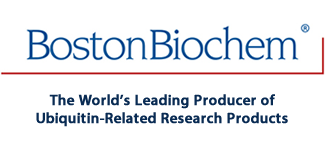
Recombinant Human SUMO1 Mutant K17R Protein, CF Summary
Product Datasheets
Carrier Free
CF stands for Carrier Free (CF). We typically add Bovine Serum Albumin (BSA) as a carrier protein to our recombinant proteins.Adding a carrier protein enhances protein stability, increases shelf-life, and allows the recombinant protein to be stored at a more dilute concentration.The carrier free version does not contain BSA.
In general, we advise purchasing the recombinant protein with BSA for use in cell or tissue culture, or as an ELISA standard.In contrast, the carrier free protein is recommended for applications, in which the presence of BSA could interfere.
ULM-714
| Formulation | Supplied as a solution in HEPES, NaCl and DTT |
| Shipping | The product is shipped with dry ice or equivalent. Upon receipt, store it immediately at the temperature recommended below. |
| Stability & Storage: | Use a manual defrost freezer and avoid repeated freeze-thaw cycles.
|
Reconstitution Calculator
Background: SUMO1
Human Small Ubiquitin-like Modifier 1 (SUMO1), also known as Sentrin, UBL1, and SMT3C, is synthesized as a 101 amino acid (aa) propeptide with a predicted molecular weight of 11.5 kDa. Human SUMO1 is the most unique of the four identified SUMO proteins and shares only 44%, 47%, and 41% aa sequence identity with SUMO2, SUMO3, and SUMO4, respectively. In contrast, human SUMO1 shares 100% aa sequence identity with the mouse ortholog. SUMOs are a family of small, related proteins that can be enzymatically attached to a target protein by a post-translational modification process termed SUMOylation (1-3). All SUMO proteins share a conserved Ubiquitin domain and a C-terminal diglycine cleavage/attachment site. Following cleavage of a four aa C-terminal prosegment, the C-terminal glycine residue of SUMO1 is enzymatically attached to a lysine residue on a target protein. In humans, SUMO1 is conjugated to a variety of molecules in the presence of the SAE1/UBA2 SUMO-activating (E1) enzyme and the UBE2I/Ubc9 SUMO-conjugating (E2) enzyme (4,5). In yeast, the SUMO-activating (E1) enzyme is Aos1/Uba2p (6). SUMOylation can occur without the requirement of a specific SUMO ligase (E3), where SUMO1 is transferred directly from UBE2I/Ubc9 to specific substrates. In Alzheimer"s disease models SUMO1 has been shown to influence the generation of Amyloid-beta peptide by promoting the accumulation of BACE-1 (7). Covalent modification of Phosphatase and Tensin Homolog Deleted on Chromosome (PTEN) by SUMO1 is thought to regulate tumorigenesis by retaining PTEN at the plasma membrane, an effect that suppresses PI 3-Kinase/Akt-dependent tumor growth (8).
Human SUMO-1 does not contain the exactpsi ΚXE consensus sequence found in SUMO-2 and SUMO-3. Within this motifpsirepresents a large hydrophobic amino acid (I, L, or V), K is the lysine that becomes modified, X is any residue and E is glutamic acid. Many known SUMO-1 conjugation sites occur within this consensus sequence, but SUMOylation also occurs on lysine residues located within non-consensus regions. SUMO-1 has been shown to form chains in vitro and in vivo, but often the linkage is uncharacterized, and the function of SUMO chains has not yet been fully elucidated. SUMO-1 multimerization in vitro has been shown to occur predominantly via lysines K7, K16 and K17. Mutation of lysine 17 to arginine is useful to investigate mono-sumoylation requirements or can be used to reduce poly-SUMO chain formation.
- Desterro, J.M. et al. (1997) FEBS. Lett. 417:297.
- Bettermann, K. et al. (2012) Cancer Lett. 316:113.
- Praefcke, G.J. et al. (2012) Trends Biochem. Sci. 37:23.
- Okuma, T. et al. (1999) Biochem. Biophys. Res. Commun. 254:693.
- Tatham, M.H. et al. (2001) J. Biol. Chem. 276:35368.
- Johnson, E.S. et al. (1997) EMBO J. 16:5509.
- Yun, S.M. et al. (2012) Neurobiol Aging. [Epub ahead of print].
- Huang, J. et al. (2012) Nat. Commun. 3:911.
FAQs
No product specific FAQs exist for this product, however you may
View all Proteins and Enzyme FAQsRecombinant Enzymes
Recombinant Human GST-MDM2/HDM2 Protein, CF
Recombinant Human His6-UBE2N (Ubc13)/Uev1a Complex, CF
Recombinant Human UBE2I/Ubc9 Protein, CF
Recombinant Human SUMO E1 (SAE1/UBA2) Protein, CF
Reviews for Recombinant Human SUMO1 Mutant K17R Protein, CF
There are currently no reviews for this product. Be the first toreview Recombinant Human SUMO1 Mutant K17R Protein, CF and earn rewards!
Have you used Recombinant Human SUMO1 Mutant K17R Protein, CF?
Submit a review and receive an Amazon gift card.
$25/€18/£15/$25CAN/¥75 Yuan/¥1250 Yen for a review with an image
$10/€7/£6/$10 CAD/¥70 Yuan/¥1110 Yen for a review without an image
ebiomall.com






>
>
>
>
>
>
>
>
>
>
>
>
2.磁珠法提取DNA试剂盒
3.DNA提取试剂盒(离心柱法)
4.磁珠法RNA提取试剂盒
5.RNA提取试剂盒(离心柱法)
6.磁珠法植物基因组DNA提取试剂盒
7.反转录试剂盒
8.胶回收试剂盒
9.PCR纯化试剂盒
10.病毒核酸提取试剂盒(磁珠法)
11.土壤基因组DNA提取试剂盒
12.法医样本DNA提取试剂盒(磁珠法)等 1.elisa
常见elisa试剂盒有:
特种蛋白检测elisa试剂盒
如免疫球蛋白,抗链O-aso,类风湿因子RF,C反应蛋白,微量白蛋白,β-2微球蛋白human,铁蛋白,转铁蛋白transferrin等等
肿瘤标志物检测elisa试剂盒:
如肿瘤标志物,组织多肽抗原,肿瘤相关因子,胰腺癌,直肠癌,细胞角蛋白片段,胃肠癌,铁蛋白,糖链抗原,神经特异性稀醇化酶,上皮膜抗原,乳腺癌,人抗小鼠抗体,前列腺,甲胎蛋白,肝癌,甲基苯丙胺,大肠癌,肺癌,大小便隐血检测,癌胚抗原,β-2微球蛋白等等。
食品安全检验elisa试剂盒:
食品中的激素、药物、霉菌毒素、过敏原残留、转基因产品的检测试剂盒,以及微生物、维生素等的检测产品。
植物病毒、细菌、真菌、植物激素和转基因作物的农业诊断试剂盒
动植物疾病诊断类如猪、牛、羊、马等家畜和禽类以及宠物类检测试剂盒
传染病检测elisa试剂盒
如幽门螺杆菌,乙脑,乙肝,丙肝,丁肝,戊肝,庚肝,衣原体,性病,腺病毒,微小病毒B19,天疱疮,水痘-带状疱疹病毒,生殖支原体,伤寒,沙眼,腮腺炎,人型支原体,麻疹,轮状病毒,流行性出血热,淋球菌,莱姆病,柯萨奇,抗解尿支原体,军团菌,结核,胶原,尖锐湿疣,甲肝,脊髓灰质炎,急性胰腺炎尿胰蛋白酶,霍乱,呼吸道合胞病毒,肝吸虫,副流感,肺炎,带状疱疹,传染性单核细胞增多症,层粘蛋白,布鲁氏杆菌,百日咳,白喉,艾柯病毒,EB病毒,A族链球菌等等。
2.免疫共沉淀试剂盒
3.化学发光试剂盒
4.免疫组化试剂盒
5.放射免疫试剂盒
6.免疫荧光试剂盒 1.细胞凋亡试剂盒
2.葡萄糖检测试剂盒
3.支原体检测试剂盒
四、试剂盒使用示例
试剂盒的产生正是为了使实验人员能够摆脱繁重的试剂配制及优化过程,所以试剂盒中一般配备有相应的使用说明书,用户按照说明书不需或只需少量的优化即可得到满意的结果。
⑴试剂盒使用说明书
说明书一般包括公司标志及名称、试剂盒名称、试剂盒组成、保质期、使用领域、使用方法等项目
说明书格式如右图所示:
①一般在页眉页脚处为公司的名称及标志;
②接下来为试剂盒的名称;
③试剂盒组成中应为试剂盒中的所有内容,为了简洁明了,一般以表格的形式表现;
④操作步骤是试剂盒说明书中最重要的部分,内容应准确、简洁、易懂,不能包含带有歧义的句子,更不能含糊其辞,排版上操作步骤应将复杂的步骤拆解,使人一目了然。可以说操作步骤为试剂盒的灵魂。 试剂盒内容(以离心柱型为例):
一般包括:裂解液RL
去蛋白液RW1
漂洗液RW
RNase free ddH2O
吸附柱(RNase free)
过滤柱(RNase free)
缓冲液
离心管(RNase free)
收集管(RNase free)
此外,还配有一份试剂盒使用说明书,根据不同的生产商,可能还配有不同的试剂,如:DNA酶、溶菌酶等。
使用时一定要根据自己的实验需要购买专用提取试剂盒, 如果不是专用试剂盒,或许能提出RNA,但不能确保其质量以及完整性,会影响RT-PCR、Northern blot、Dot blot、Real time RT PCR、芯片分析、polyA 筛选、体外翻译、RNase 保护分析、分子克隆等后续实验的结果。
当前提取效果好的是QIANGEN公司生产的RNA提取试剂盒,但其售价较高,单次实验费用花费太大,对精度要求不高的实验没有必要购买,当然还有其它的进口试剂盒,但是均存在价格高、订货周期长的问题(如果碰上国内无货的时候,要从国外发货,会等很长一段时间)。普通的提取实验用国产的试剂盒就足以,价格不高,基本上各地均有现货,如天根(目前国内生产的试剂盒中销售面比较广的一种)等,其价格比进口试剂盒要便宜许多,且效果还不错,性价比还可以。
当然,就RNA的提取而言,不一定试剂盒的提取效果就非常好,其实采用一些经典的RNA提取方法,效果也很不错,如:TRIZOL、EDTA等,只是试剂盒使用方便,经典的方法操作复杂一些。向左转|向右转
想通过亲和层析来纯化抗血小板特异性抗体(抗GPIIb/IIIa抗体和抗GPIbα抗体),能否做到呢?谢谢!
看了下说明书,上面没有具体说。感觉捕获抗体和酶标抗体需要对HCP有不同的结合位点才能形成稳定的抗体-HCP-抗体复合物。不知道有没有战友熟悉,求解惑,谢谢!
我的实验是这样的,先纯化质粒,然后做酶切,再纯化DNA。
最后一步其实也可以用切胶回收试剂盒,我怕做不好,所以想选用DNA纯化试剂盒,但不知跟质粒DNA提取试剂盒是否有区别,因为说明书上说可以用Invitrogen的K210001.我搜索看了一席啊,觉得那个是提取质粒的小提啊。所以产生这个疑问,请大侠告知DNA纯化试剂盒与质粒DNA提取试剂盒这两者之间有区别吗?
用哪个公司的DNA纯化试剂盒比较好。谢谢啦!









